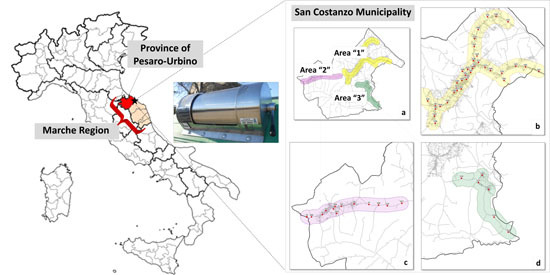Environmental and Social Sustainability of the Proximity Waste Collection System: A Case-Study Evaluation at an Italian Local Scale
Abstract
:1. Introduction
2. Material and Methods
2.1. The Case-Study Area
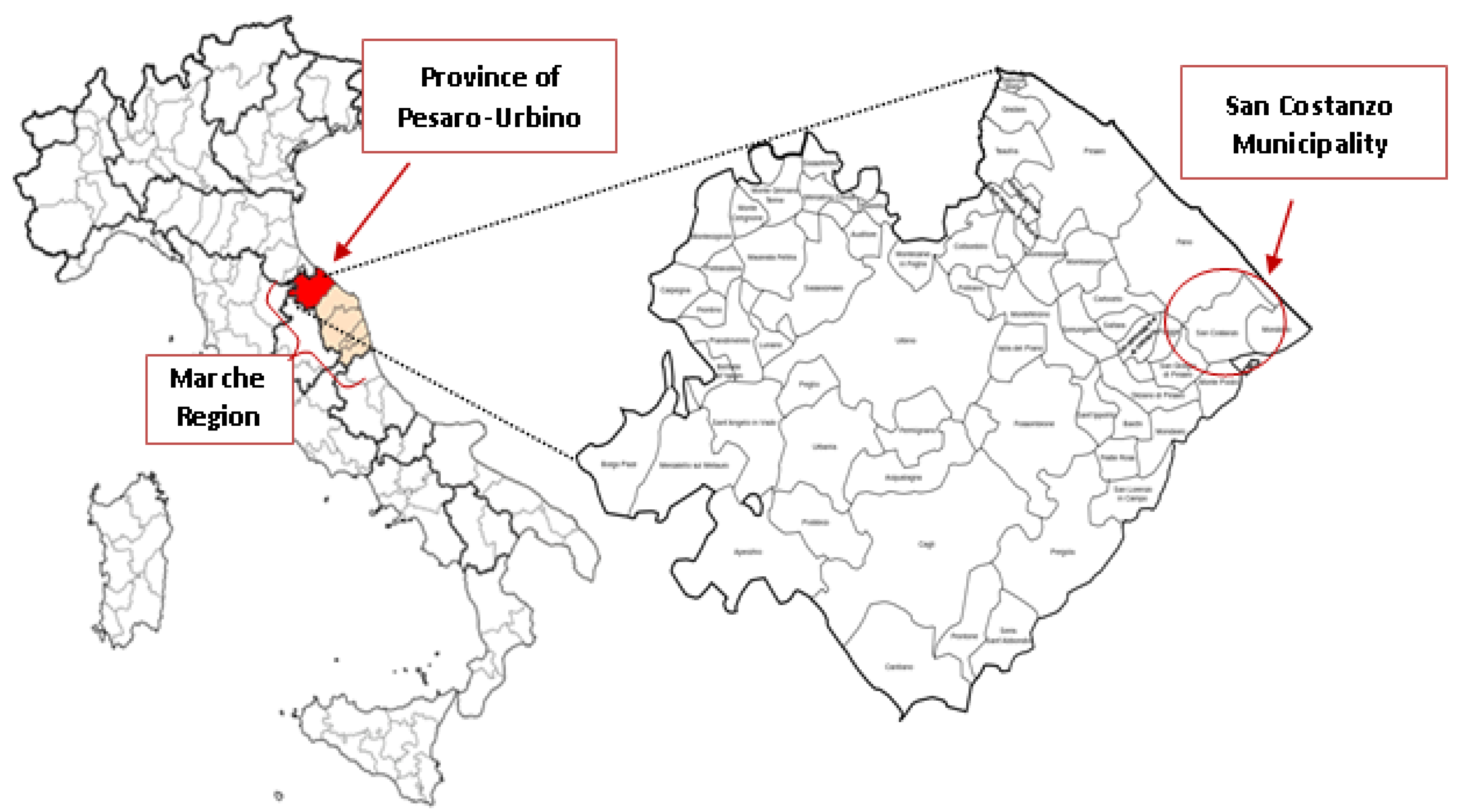
2.2. Temporal Evolution of the MSW Collection System in the Case-Study Area
| Waste Fraction | Road Waste Collection Scheme | Proximity Waste Collection Scheme |
|---|---|---|
| Unsorted Residual Waste (URW) |
|
|
| ||
|
| |
| Paper and Cardboard |
|
|
| Plastic and plastic packaging |
|
|
|
| |
| Glass |
|
|
| Household hazardous waste |
| Unchanged respect to the road collection scheme |
| Biowaste | ------------------------- |
|
| ||
| Garden/Yard Waste | ------------------------- |
|
| Metals | ------------------------- |
|
- A collection centre of source-segregated waste in Fano: This very large waste centre is generally open 07:45–12:30 a.m. on Tuesdays, Thursdays, Fridays and Saturdays, whereas 13:15–18:00 p.m. is the opening time on Mondays and Wednesdays. Citizens may bring a wide range of waste types to this recycling station by segregating them previously at their own homes. The following materials may be accepted: Paper and cardboard, plastic, glass, steel, aluminium, vegetable oils, mineral oils, batteries, expired drugs, toxic and flammable waste (T/F) as, for example, spray nozzles, electric and electronic equipment, consumable office supplies, wood and pruning residues and discarded clothes. Once collected, the different waste types are sent to the proper treatment facilities for the recovery or the correct disposal;
- A requested kerbside collection scheme for bulky waste at single or multi-family housing: Items such as discarded furniture, white goods, bathroom furniture, pruning waste and other household waste that are not suitable to be thrown into the road containers or to be brought to the collection center, due to their size and nature, are generally treated through this system;
- Landfilling of the URW at the “Fano” sanitary landfill for non-hazardous waste, which is owned and operated by the “ASET” group itself.
2.3. The Introduction of the Proximity Waste Collection System
2.3.1. Collection Islands
2.3.2. Device for the URW
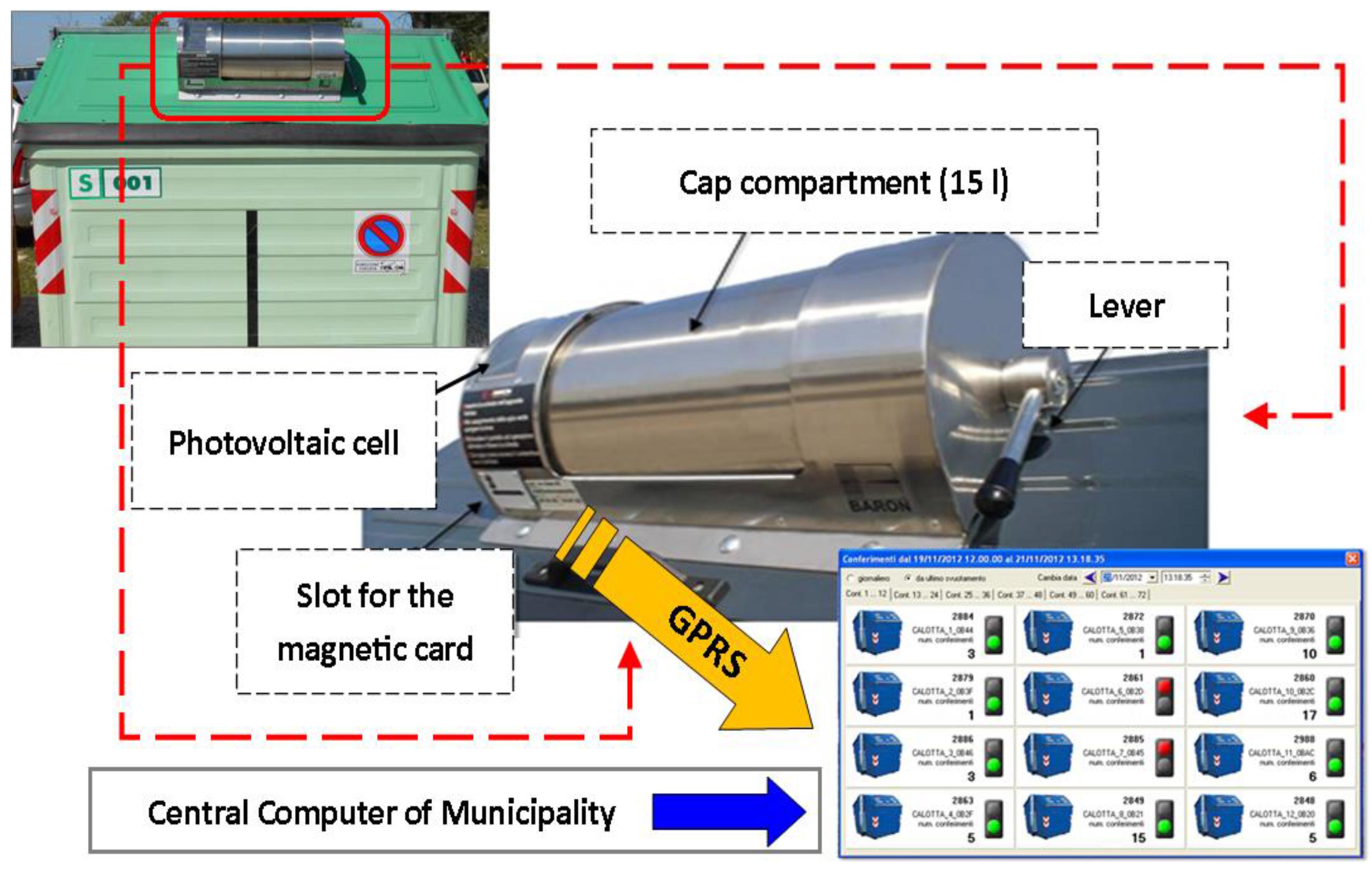
2.4. Environmental Performance of the Two Waste Collection Systems: Data Gathering and Elaboration
- Waste Generation Rate (WGR) [kgwaste/capita year]
- Waste Collection Rate (WCR) [kgwaste/capita year]
- Source Separation Level (SSL) [% by weight]:
- Interception Rate (IR) [% by weight]:
2.5. URW Sorting: Data Gathering and Elaboration
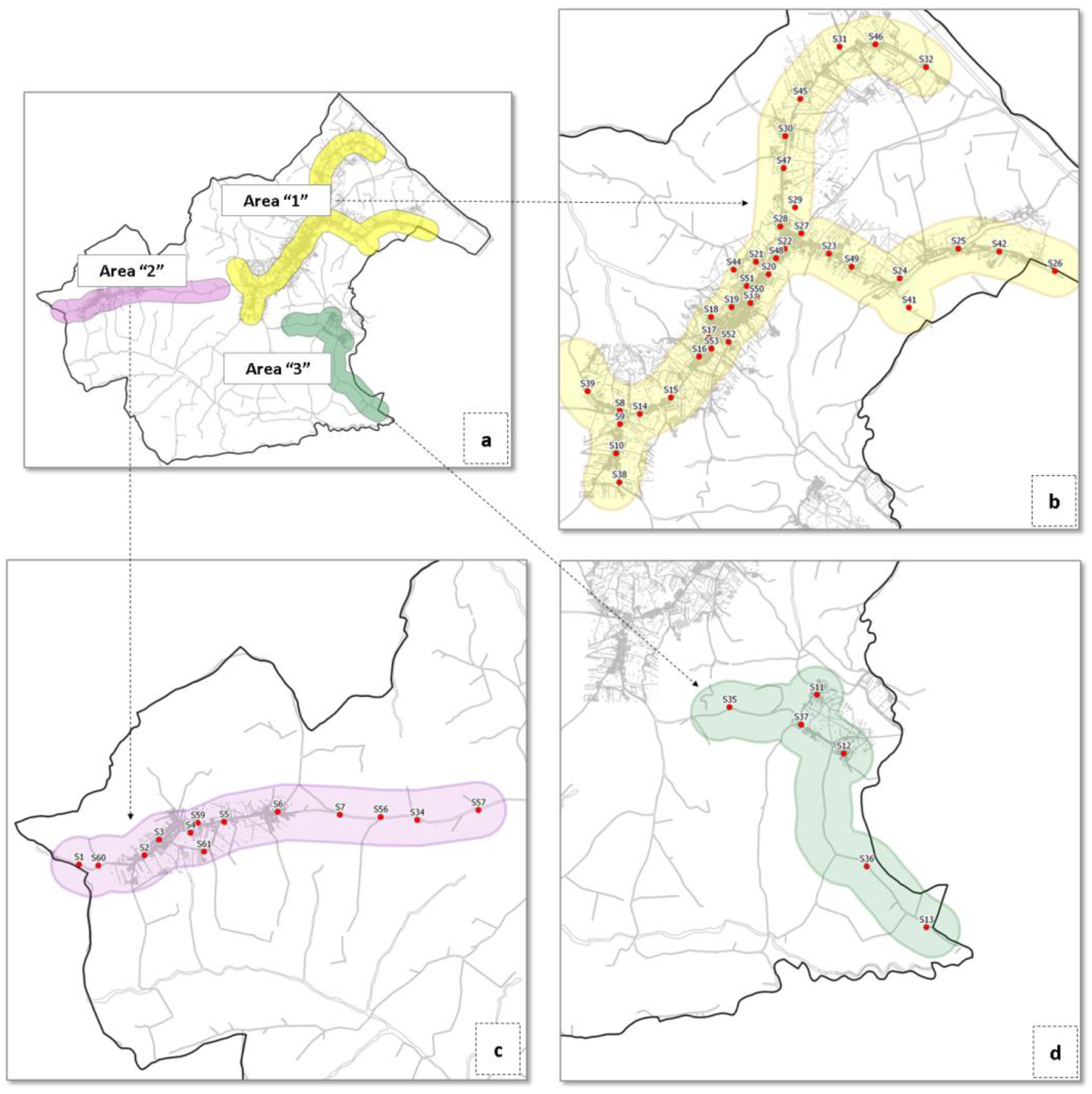
3. Results and Discussion
3.1. Environmental Performance Evaluation
3.1.1. Waste Generation Rate (WGR) and Waste Collection Rates (WCRi)
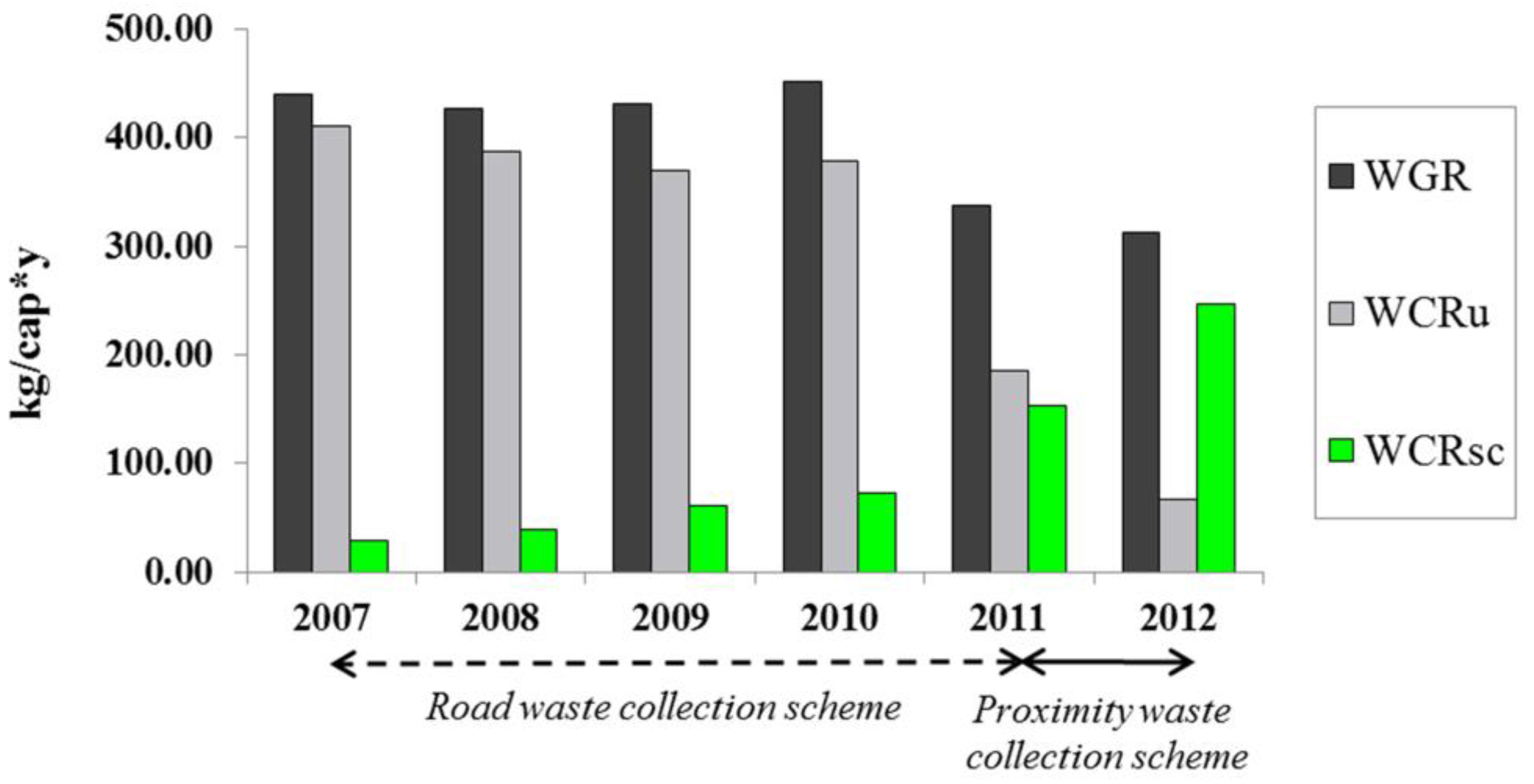
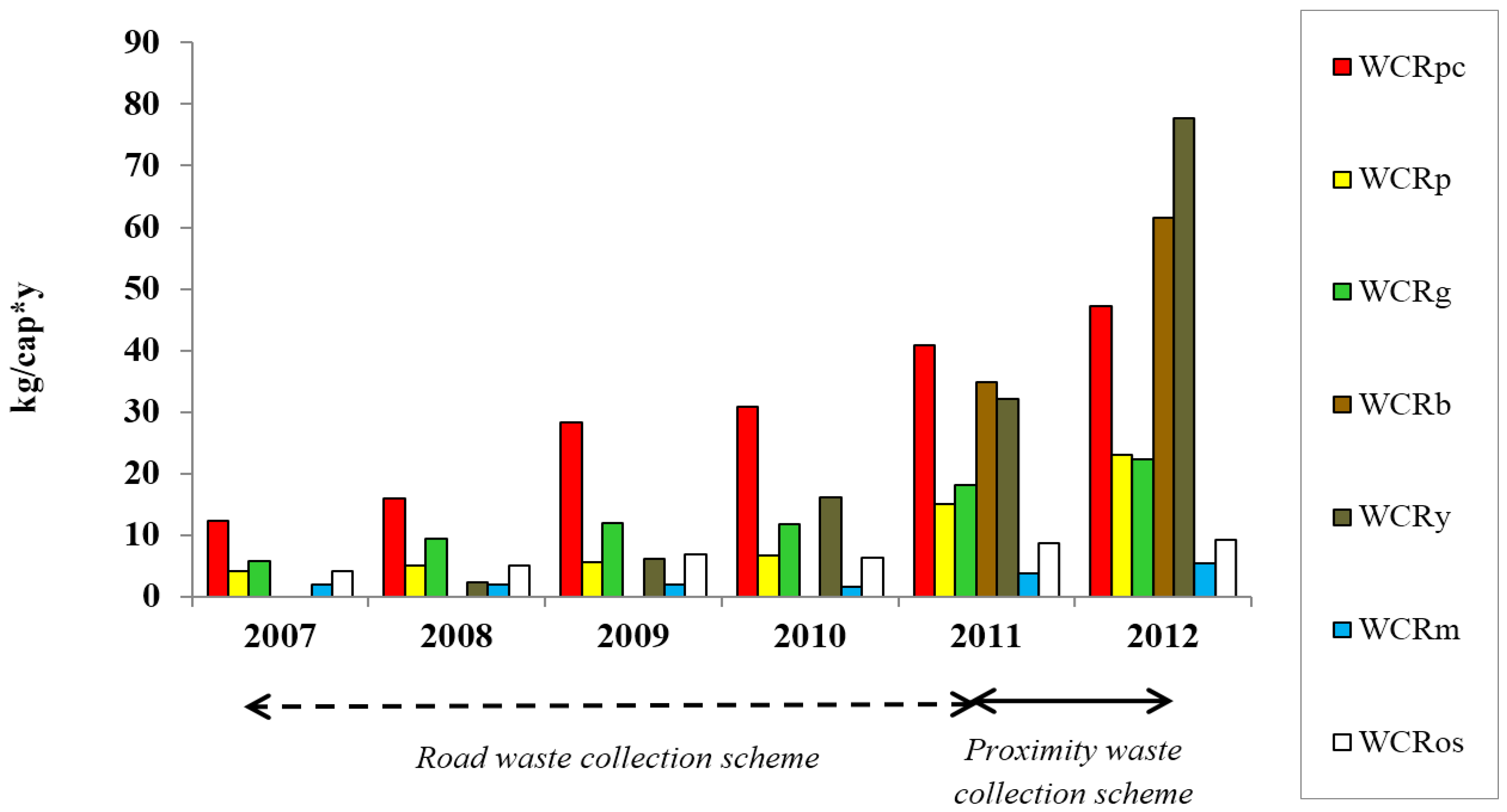
3.1.2. Source Separation Level (SSL) Results
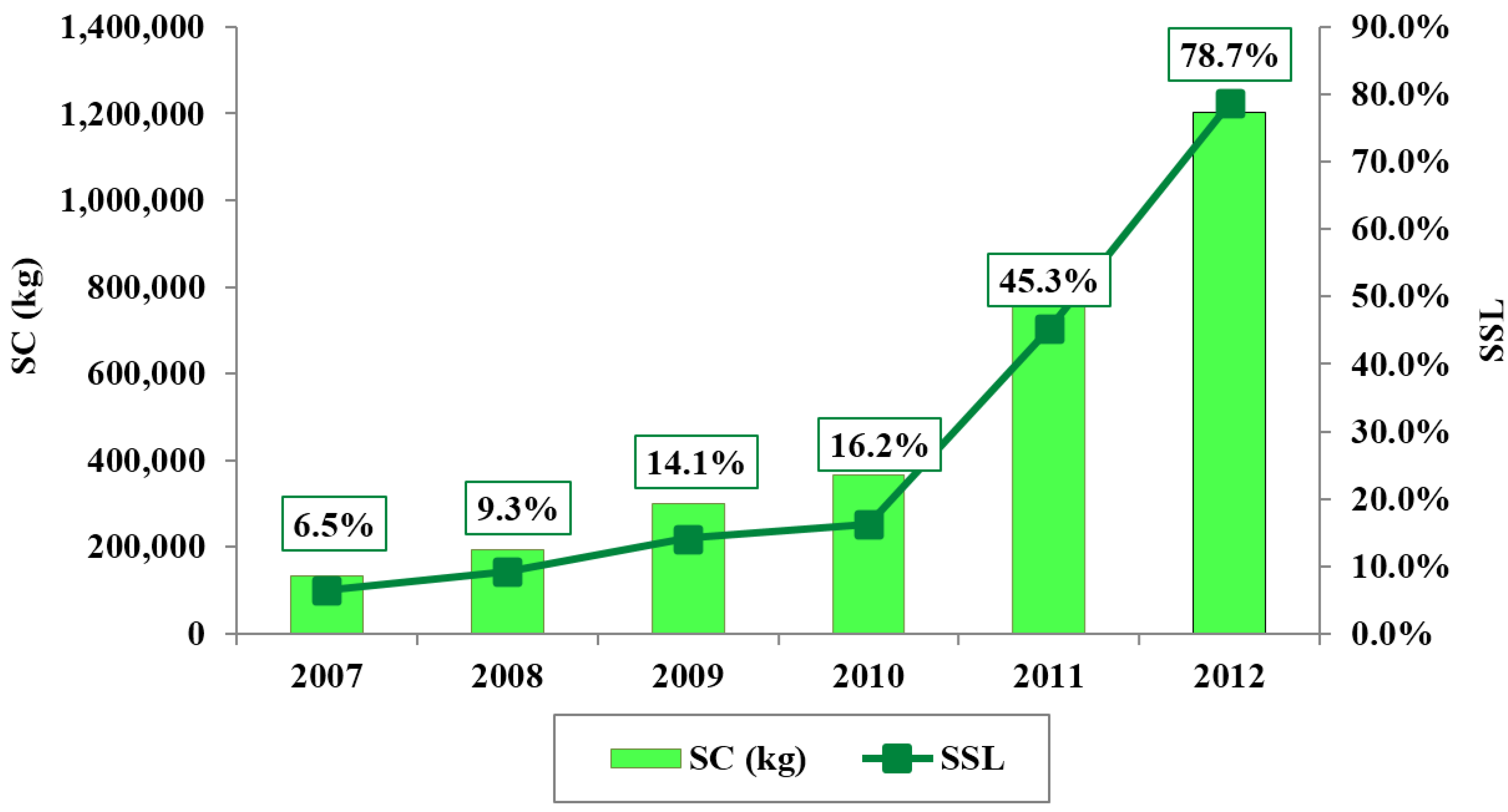
3.1.3. Interception Rates (IRi) in the San Costanzo Municipality in 2007–2012
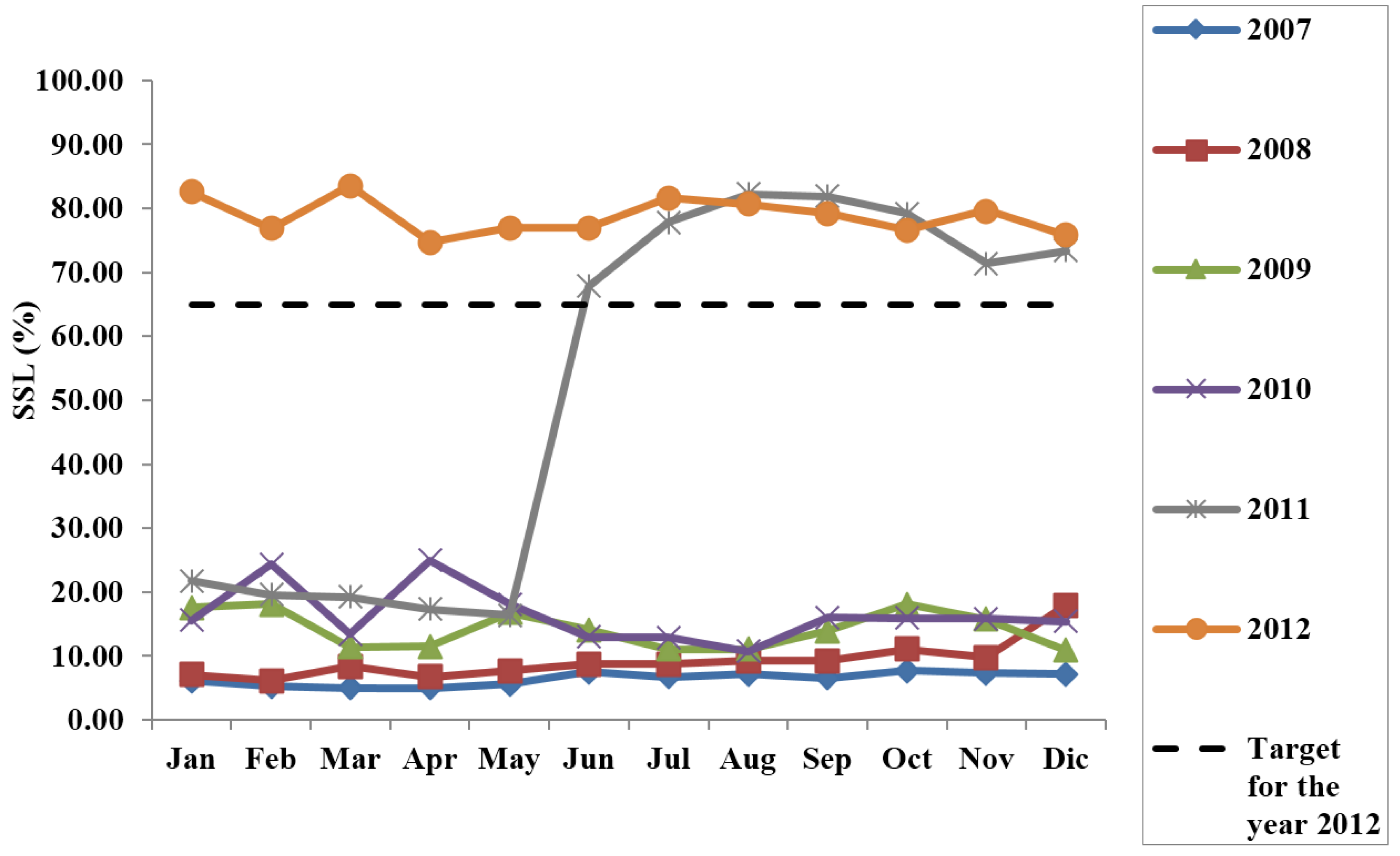
| IRi | Road Waste Collection System | Proximity Waste Collection System |
|---|---|---|
| IRpc (%) | 33.49 | 84.29 |
| IRp (%) | 18.65 | 61.00 |
| IRg (%) | 69.25 | 95.87 |
| IRb (%) | 0.00 | 83.23 |
| IRy (%) | 6.57 | 97.59 |
| IRm (%) | 9.76 | 88.86 |
| IRos (%) | 6.50 | 23.86 |
3.2. Citizen’s Behaviour in the Setting out of URW
| Set-Outs vs. Temporal Unit | Area “1” | Area “2” | Area “3” | Total Area | |
|---|---|---|---|---|---|
| No.s.o. month−1·year −1 | January | 209.27 | 112.23 | 64.50 | 171.23 |
| February | 161.14 | 96.62 | 51.83 | 134.45 | |
| March | 223.41 | 119.92 | 67.50 | 182.68 | |
| April | 219.89 | 122.38 | 77.33 | 181.98 | |
| May | 75.46 | 53.23 | 37.00 | 66.18 | |
| June | 65.35 | 55.15 | 42.50 | 60.54 | |
| July | 239.05 | 133.00 | 78.83 | 197.27 | |
| August | 233.81 | 131.54 | 82.00 | 193.80 | |
| September | 56.59 | 42.15 | 22.67 | 49.61 | |
| October | 222.19 | 90.92 | 65.83 | 174.96 | |
| November | 191.65 | 81.92 | 57.17 | 151.77 | |
| December | 193.78 | 119.46 | 53.00 | 161.45 | |
| No.s.o. week’s day −1·year −1 | Monday | 310.11 | 163.62 | 99.17 | 253.50 |
| Tuesday | 286.54 | 163.46 | 94.00 | 237.34 | |
| Wednesday | 296.11 | 161.38 | 94.83 | 243.27 | |
| Thursday | 297.49 | 177.23 | 99.33 | 248.34 | |
| Friday | 295.19 | 161.15 | 121.67 | 245.48 | |
| Saturday | 339.22 | 182.92 | 111.83 | 278.57 | |
| Sunday | 266.95 | 148.77 | 79.33 | 219.41 | |
| No.s.o. time frame −1·year −1 | 0–2 a.m. | 8.00 | 4.23 | 7.00 | 7.02 |
| 2–4 a.m. | 2.70 | 0.62 | 0.67 | 2.00 | |
| 4–6 a.m. | 6.70 | 3.23 | 1.17 | 5.30 | |
| 6–8 a.m. | 133.89 | 72.08 | 55.17 | 111.11 | |
| 8–10 a.m. | 381.46 | 201.62 | 116.17 | 311.29 | |
| 10–12 a.m. | 361.57 | 178.46 | 125.50 | 293.77 | |
| 12 a.m.–2 p.m. | 230.54 | 112.08 | 129.17 | 192.18 | |
| 2–4 p.m. | 280.05 | 171.54 | 72.33 | 232.61 | |
| 4–6 p.m. | 278.14 | 155.00 | 65.00 | 226.71 | |
| 6–8 p.m. | 208.54 | 121.77 | 65.17 | 173.04 | |
| 8–10 p.m. | 157.35 | 101.85 | 40.33 | 131.93 | |
| 10–12 p.m. | 42.65 | 36.08 | 22.50 | 38.96 | |
| No. of Set-Outs | Area “1” | Area “2” | Area “3” | Total Study Area |
|---|---|---|---|---|
| % users recorded | % users recorded | % users recorded | % users recorded | |
| 1–5 | 54.24 | 64.19 | 65.17 | 56.52 |
| 5–10 | 24.81 | 21.13 | 20.23 | 23.94 |
| 10–20 | 15.71 | 10.72 | 11.77 | 14.64 |
| >20 | 5.25 | 3.96 | 2.82 | 4.91 |
4. Conclusions
Acknowledgments
Author Contributions
Conflicts of Interest
References
- McDougall, F.; White, P.R.; Franke, M.; Hindle, P. Waste collection. In Integrated Solid Waste Management: A Lifecycle Inventory, 2nd ed.; Blackwell Science: Oxford, UK, 2001; pp. 193–226. [Google Scholar]
- Torretta, V.; Ionescu, G.; Raboni, M.; Merler, G. The mass and energy balance of an integrated solution for municipal solid waste treatment. WIT Trans. Ecol. Environ. 2014, 180, 151–161. [Google Scholar]
- Rada, E.C.; Ragazzi, M.; Ionescu, G.; Merler, G.; Moedinger, F.; Raboni, M. Municipal Solid Waste treatment by integrated solutions: Energy and environmental balances. Energy Procedia 2014, 50, 1037–1044. [Google Scholar] [CrossRef]
- The European Parliament; The Council of the European Union. Directive 2008/98/EC of the European Parliament and of the Council on waste and repealing certain Directives (WFD). Off. J. Eur. Union 2008, 34, 99–126. [Google Scholar]
- Ploechl, C.; Dobson, G.; Buell, U. A Class of its Own—Standardization of Solid Waste Analyses in the EU. In Waste Management World; International Solid Waste Association: Wien, Austria, 2003; pp. 32–40. [Google Scholar]
- Dahlén, L.; Vukicevic, S.; Meijer, J.; Lagerkvist, A. Comparison of different collection systems for sorted household waste in Sweden. Waste Manag. 2007, 27, 1298–1305. [Google Scholar] [CrossRef] [PubMed]
- Mattsson, C. Waste management and producer responsibility in Sweden. Licentiate thesis, Chalmers University of Technology, Gothenburg, Sweden, 2003. [Google Scholar]
- Gallardo, A.; Bovea, M.; Colomer, F.; Prades, M.; Carlos, M. Comparison of different collection systems for sorted household waste in Spain. Waste Manag. 2010, 30, 2430–2439. [Google Scholar] [CrossRef] [PubMed]
- Gallardo, A.; Bovea, M.; Colomer, F.; Prades, M. Analysis of collection systems for sorted household waste in Spain. Waste Manag. 2012, 32, 1623–1633. [Google Scholar] [CrossRef] [PubMed]
- Consonni, S.; Viganò, F. Material and energy recovery in integrated waste management systems: The potential for energy recovery. Waste Manag. 2011, 31, 2074–2084. [Google Scholar] [CrossRef] [PubMed]
- Giugliano, M.; Cernuschi, S.; Grosso, M.; Rigamonti, L. Material and energy recovery in integrated waste management systems. An evaluation based on life cycle assessment. Waste Manag. 2011, 31, 2092–2101. [Google Scholar] [CrossRef] [PubMed]
- Massarutto, A.; de Carli, A.; Graffi, M. Material and energy recovery in integrated waste management systems: A life-cycle costing approach. Waste Manag. 2011, 31, 2102–2111. [Google Scholar]
- Environmental Framework Regulation, Annex of the Italian Official Gazette No. 88; Legislative Decree No. 152; Official Gazette of the Italian Republic: Rome, Italy, 2006. (In Italian)
- Sanchenko, Y. Italian Best Practices in Waste Management. Transnational Workshop on Zero Waste Application. Available online: http://www.ecotech.cat/grecia/ (accessed on 7 April 2011).
- Province of Turin. Report on the Status of the Waste Management System. Available online: http://www.provincia.torino.gov.it/ambiente/file-storage/download/rifiuti/pdf/rapporto_10/Cap_2.pdf (accessed on 17 December 2013).
- Ranieri, E.; Rada, E.C.; Ragazzi, M.; Masi, S.; Montanaro, C. Critical analysis of the integration of residual municipal solid waste incineration and selective collection in two Italian tourist areas. Waste Manag. 2014, 32, 551–555. [Google Scholar] [CrossRef] [PubMed]
- Consonni, S.; Giugliano, M.; Massarutto, A.; Ragazzi, M.; Saccani, C. Material and energy recovery in integrated waste management systems: Project overview and main results. Waste Manag. 2011, 31, 2057–2065. [Google Scholar] [CrossRef] [PubMed]
- Bianchini, A.; Pellegrini, M.; Saccani, C. Material and energy recovery in integrated waste management systems: An Italian case study on the quality of MSW data. Waste Manag. 2011, 31, 2066–2073. [Google Scholar] [CrossRef] [PubMed]
- Nilsson, P.; Christensen, T.H. Waste collection: Systems and Organization. In Solid Waste Technology & Management; Christensen, T.H., Ed.; John Wiley & Sons: Chichester, UK, 2010; Volume 1, pp. 277–295. [Google Scholar]
- ATIA-ISWA Italia—Regione Toscana. Sistemi di Calcolo Delle Raccolte Differenziate. Available online: http://www.regione.toscana.it/-/sistemi-di-calcolo-delle-raccolte-differenziate (accessed on 7 August 2013).
- Dahlén, L. Household Waste Collection, Factors and Variations. Ph.D. Thesis, Department of Civil, Mining and Environmental Engineering, Division of Waste Science and Technology, University of Technology, Luleå, Sweden, 2008. [Google Scholar]
- Woodard, R.; Harder, M.K.; Bench, M. Participation in curbside recycling schemes and its variation with material types. Waste Manag. 2006, 26, 914–919. [Google Scholar] [CrossRef] [PubMed]
- World Meteorological Organization (WMO). Cold Spell in Europe and Asia in Late Winter 2011/2012, Issued by WMO Regional Climate Centres (20p.): RA II (Asia): Tokyo Climate Centre, Japan Meteorological Agency (JMA); RA VI (Europe): Pilot Regional Climate Centre, Node on Climate Monitoring (RCCCM), Lead Centre Deutscher Wetterdienst (DWD), Germany. Available online: https://www.wmo.int/pages/mediacentre/news/documents/dwd_2012_report.pdf (accessed on 29 January 2015).
- Tucker, P.; Speirs, D. Count me as doing my bit: An appraisal of the accuracy of waste attitude/behaviour surveys. CIWM Sci. Tech. Rev. 2003, 4, 9–18. [Google Scholar]
- Woolam, T.C.; Emery, A.; Griffiths, A.J.; Williams, K.P. A comparison of intended and claimed recycling behaviour to actual in a new kerbside scheme. CIWM Sci. Tech. Rev. 2003, 4, 2–9. [Google Scholar]
© 2015 by the authors; licensee MDPI, Basel, Switzerland. This article is an open access article distributed under the terms and conditions of the Creative Commons Attribution license (http://creativecommons.org/licenses/by/4.0/).
Share and Cite
Carchesio, M.; Tatàno, F.; Goffi, M.; Radi, M. Environmental and Social Sustainability of the Proximity Waste Collection System: A Case-Study Evaluation at an Italian Local Scale. Sustainability 2015, 7, 7492-7511. https://doi.org/10.3390/su7067492
Carchesio M, Tatàno F, Goffi M, Radi M. Environmental and Social Sustainability of the Proximity Waste Collection System: A Case-Study Evaluation at an Italian Local Scale. Sustainability. 2015; 7(6):7492-7511. https://doi.org/10.3390/su7067492
Chicago/Turabian StyleCarchesio, Manuela, Fabio Tatàno, Margherita Goffi, and Michele Radi. 2015. "Environmental and Social Sustainability of the Proximity Waste Collection System: A Case-Study Evaluation at an Italian Local Scale" Sustainability 7, no. 6: 7492-7511. https://doi.org/10.3390/su7067492
APA StyleCarchesio, M., Tatàno, F., Goffi, M., & Radi, M. (2015). Environmental and Social Sustainability of the Proximity Waste Collection System: A Case-Study Evaluation at an Italian Local Scale. Sustainability, 7(6), 7492-7511. https://doi.org/10.3390/su7067492





